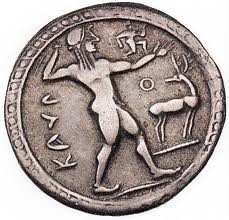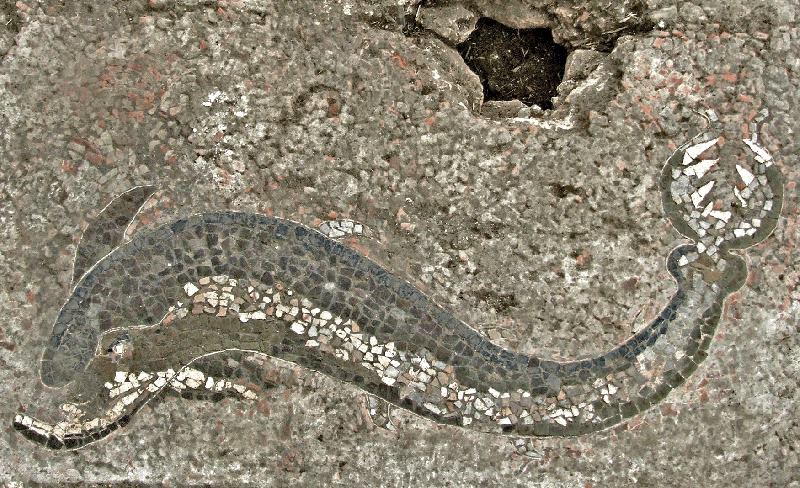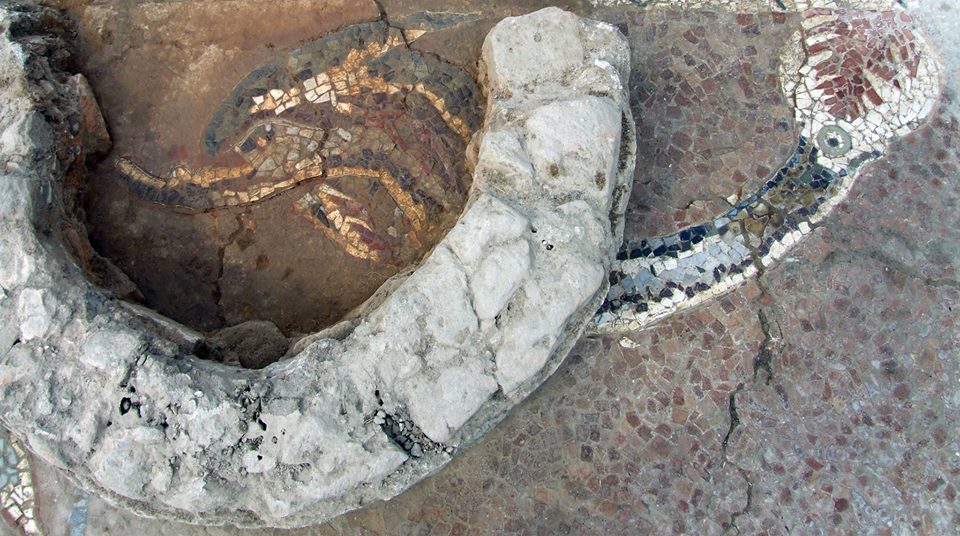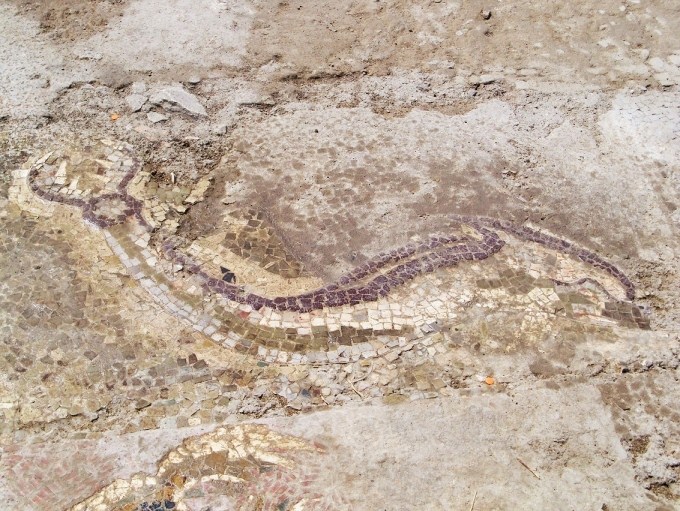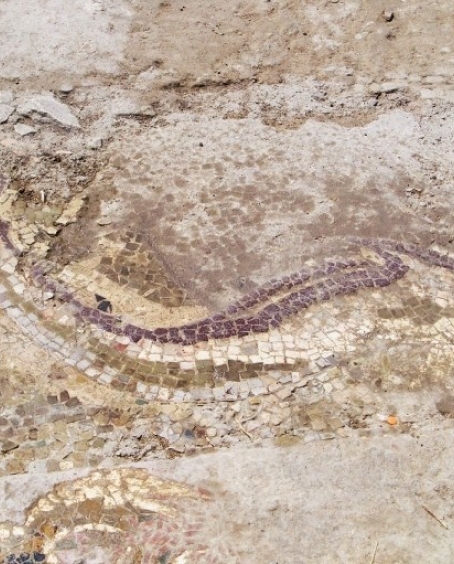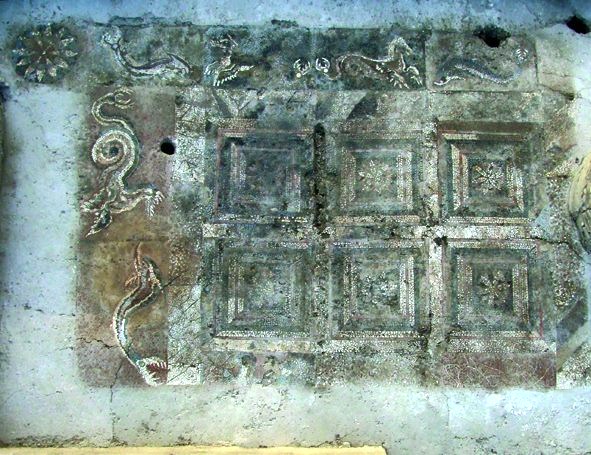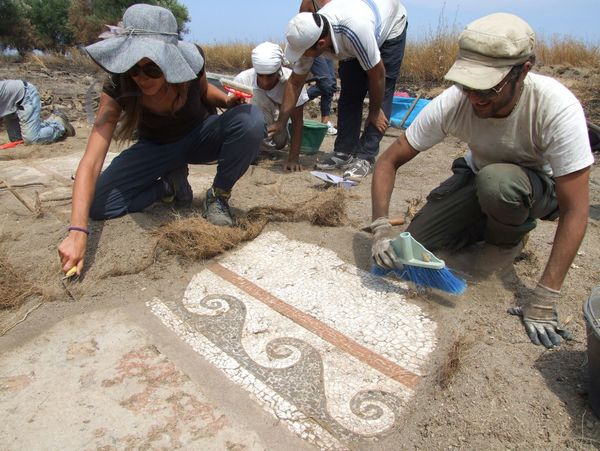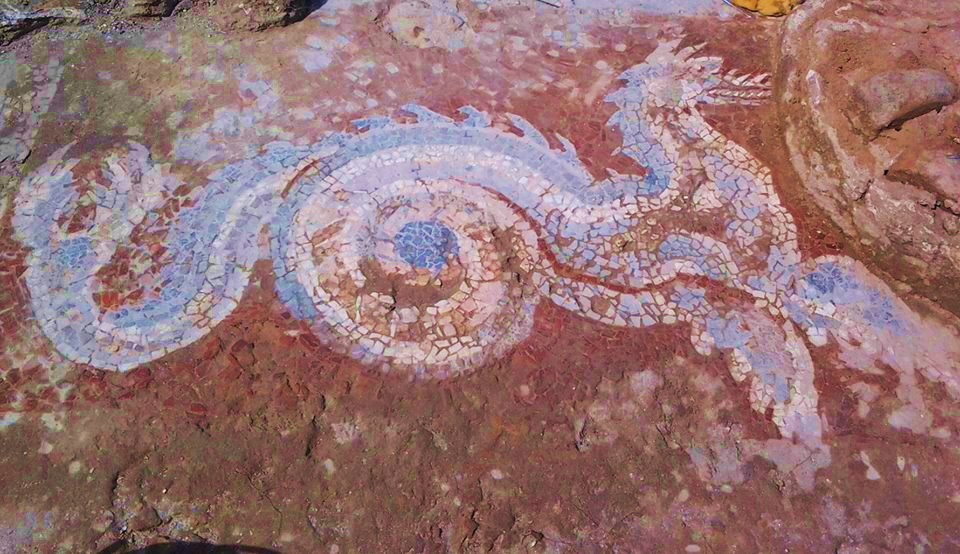
Calabria – The wonderful blue drakon found in 2012 during excavations in the ancient greek colony of Kaulonia, Monasterace Marina (Reggio Calabria) – Courtesy of Archaeological Museum of Monasterace | Photo gallery below
by FdS Editorial Staff
“After the river Sagra there is Caulonia, city founded by Achaeans, previously named Aulonia because of the near deep valley. Now it is abandoned …”
Strabone (first century BC), Geography, VI, 1, 10
![]() Ancients believed that dragons had an apotropaic value as they had the duty to ward evil off, while dolphins, considered sacred to Apollo and man’s friends by Greeks, symbolized the ability to deal with and overcome adversity, like the latest results of a story of zealous scientific work going on for a century remind us. This story starts when the great archaeologist from Trento Paolo Orsi spotted the site of the ancient Kaulon in Monasterace Marina, Calabria, and continues until the most recent and greatly valuable finds absolutely unique in their kind.
Ancients believed that dragons had an apotropaic value as they had the duty to ward evil off, while dolphins, considered sacred to Apollo and man’s friends by Greeks, symbolized the ability to deal with and overcome adversity, like the latest results of a story of zealous scientific work going on for a century remind us. This story starts when the great archaeologist from Trento Paolo Orsi spotted the site of the ancient Kaulon in Monasterace Marina, Calabria, and continues until the most recent and greatly valuable finds absolutely unique in their kind.
THE CITY AND THE MITH OF THE AMAZON CLETE
Let us start from the beginning. One cannot speak of Caulonia (in Greek Καυλωνια) without getting suggestively lost in the mists of myth where the line between history and legend fades away. The most fascinating legend about the origins of Caulonia dates back to the fourth century BC, and narrates the remote presence on site of the amazon Clete, Penthesilea’s nurse, queen of the Amazons. The woman-warrior would have landed here after the Trojan War when, her queen dead in battle and the decision to return home taken, a storm made her end up with her ship off the coast of southern Italy. Clete would live here when Greek Troy veterans before and Achaean colonists led by Typhoon Aegium after arrived landing in this part of the coast of Calabria (the ancient Bruzio), nearby the promontory of Cocynthus (nowadays Punta Stilo). Legend has it that people from Crotone came in support of Achaeans, and destroyed the kingdom of Clete. Her son Caulon, sole survivor of the massacre, rebuilt the city, and named it Caulonia after his own name, thus becoming its eponymous hero. The myth says so.
On the contrary, official sources consider that in the eighth century BC those same Achaeans founded the city that afterwards ended under the influence of Crotone. The city extended just south of the river Sagra, on whose banks the famous Battle of Sagra took place in the sixth century BC, and Caulonia, allied with Crotone, was defeated by Locri Epizefiri and Rhegion (Reggio) thanks to the miraculous intervention of the Dioscuri. Despite Caulonia stood in an area provided with numerous natural resources such as timber and mineral deposits of copper, silver and lead, and in a strategic position with local architectural-stone quarries, it would be subordinate to Crotone in the course of time, which prevented it from reaching the importance of other cities like Crotone, Sibari, Taranto, Reggio etc. However, Caulonia was among the first cities of Ancient Greece to mint silver coins: numerous coins made of metal mined in the Stilaro valley have been found indeed. The oldest ones (from the sixth century BC) are the “stateri incusi” (“incuse staters”), with figures and inscription hollowed on the reverse side, and in relief on the obverse side: a long-haired nude male figure, a smaller one standing next to a deer with its head turned back, and the Greek inscription Kaul.
After the anti-Pythagorean revolution in the 50s of the fifth century BC, Caulonia turned into an independent state, but even then continued to live in the shadow of Crotone. Towards the end of the fourth century BC, Caulonia, Crotone, and Sibari gave birth to the Achaean League, that would turn into the Italiota League to defend against Lucanians and, shortly after, Dionysius the Elder of Syracuse. After the victory over the Italioti at the Elleporo river (389 BC), Dionysius conquered the city, entrusted the territory to the Locresi, deported Caulonia inhabitants to Siracusa, granting them citizenship, and exempting them from taxes for five years. The city rose again after the fall of Dionysius’ empire, but later fell under the control of Reggio, which Romans helped Caulonia to get freed from (270 BC). During the Second Punic War, it was just a village, while in the time of Pliny the Elder (first century AD), there were only its ruins.
ONE CENTURY AGO, THE FINDING OF THE REMAINS OF THE CITY. THE ‘HOUSE OF THE DRAGON’ AND SUCCESSIVE EXCAVATIONS
At the beginning of the nineteenth century, the archaeologist Paolo Orsi recognized the city of Caulonia in the vestiges and finds brought to light near the headland of Punta Stilo (previously named Capo Cocinto), between the mouths of two small rivers, Aces in the north, and Stilaro in the south. The city – no more than 10,000 inhabitants – was built in an area formed by a narrow coastal plain crossed by torrential rivers, and hills before the Apennine ridge of Serre. Excavations identified the structure of the city that included a major urban center, in Hippodamian plan, sea-leveled and surrounded by walls, with a Doric temple, possibly dedicated to Apollo or Zeus, still visible in its foundations (along with an altar in sandstone, a stairway, and other facilities.) Since 1999, the Scuola Normale Superiore and the University of Pisa have been excavating the area, and have unearthed a good section of the urban sanctuary the Doric temple was part of. Orsi – who conducted excavations here from 1911 to 1916 – declared the Doric temple under protection, whereas in 1957, the Superintendent Alfonso De Franciscis declared the entire ancient city under protection. Already in the 50s, topographical and urban studies have been conducted by Schmiedt and Chevallier, thus interrupting a long period of silence on the city. De Franciscis deepened those searches, followed by Bruno Chiartano who searched near the temple, and Elena Tomasello who studied the walls and a sector of the town. Since the 80s, archaeological investigations have been taken systematically thanks to the efforts of Maria Teresa Iannelli, an official of the Regional Superintendence for Archaeological Heritage, which has also asked schools and foreign institutions for collaboration.
Among the significant finds unearthed over time, there are those outside the city walls, especially on the Tersinale hill close to the rural building of Passoliera. There, Orsi identified another important cultural center as evidenced by the numerous finds collected in the area like some deposits of architectural-terracotta fragments. They refer to three different phases of construction of a small temple, and consist of an arcaic sìma (frame) of the late sixth century BC, and other frames with beautiful lion-headed eaves of the first half of the fifth century. The submerged heritage retrieved from the sea is important as well, and includes the impressive remains of an Ionic temple, on display at the Museum of Monasterace. The area is so rich to justify the restriction applied also to the stretch of sea in front of the park. This area gave back two vases in terracotta still full of pitch, one of the products that made Calabria famous in antiquity. Technically defined kadoi, they are very rare exemplars comparable only to some others found in Apulia.
The archaeological site includes not only the areas used for worship, but also a large sector of the ancient village of Kaulonia: although only the foundations of many house walls got preserved, in-depth studies could reconstruct the history of the site. Among them, the so-called House of the Dragon stands out. Its name derives from a beautiful mosaic of the Hellenistic period, large two meters by one, depicting a back-crested and fish-tailed sea dragon. It has been found in the doorway of a room completely paved with mosaics decorated with stylized sea waves. The room, identified by archaeologists as a dining room where banquets and symposia were held, was a state room. The construction technique, the use of large marble tiles, colored stones, and thin sheets of lead suggested that the floor was made in the third century BC, being the oldest mosaic in Calabria. Discovered by De Franciscis in the late 60s, it was removed and exposed at the National Museum of Reggio Calabria for long. Recently, it returned to Monasterace where it can be admired at the local Archaeological Museum. In 2012, the “dragon of Kaulonia” had its first international launch thanks to the artist Luigi Gallo which made an identically themed mural on a large wall of the port in Bahia Blanca, Argentina.
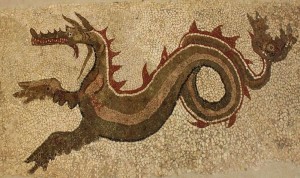
Calabria – The drakon of Kaulonia, the ancient greek colony on the Ionian Sea, Monasterace (Reggio Calabria). It is the the mosaic discovered in the 60s by Alfonso De Franciscis and now housed in the Archaeological Museum of Monasterace
Archaeological research from the past decade involved almost exclusively the sea front of the city where, in the town area called San Marco Nordest (St. Mark Northeast), the University of Florence has been operating since 2003 under the direction of Prof. Lucia Lepore, and with permission of the Superintendence for Archaeological Heritage of Calabria. This part of Caulonia stands between the Ionian Sea at east, the Taranto-Reggio Calabria railway at west, the river Assi at north, and Casamatta at south. Vascular fragments prove humans have been present in the area since the eighth century BC, Greeks settling in permanently since the early decades of the seventh century. The remains of the house of a well-to-do family, called Casa del Personaggio Grottesco (House of the Grotesque Character) come from a successive period. A road, wide 6,65 meters and going from north to south, was located nearby. The remains of a large building, partly under the current highway 106, date back to the third century BC. Finally, excavations unearthed the remains of a small necropolis from late antiquity (VI-VII century AD.)
The Archaeological Superintendence of Calabria with the contribution of the Mediterranean University of Reggio Calabria, and the University of Calabria operate in the vast complex of Casamatta (whose name refers to a military structure of the Second World War). Some of the latest findings come from this area.
THE RECENT EXTRAORDONARY FINDINGS
From 2012 to date, Caulonia has been the set of a blaze of findings of international importance. We shall retrace events. In summer 2012, excavations at the Doric Temple surfaced a helmet and a decorated greave dating back to the sixth century BC. In 2014, excavations in Casamatta led to the discovery of an extraordinary mosaic depicting a dragon, a rose window, nine square and three rectangular panels with floral motifs. The discovery was made on the last day of the twenty-fourth excavation campaign, during the unearthing of a monumental thermal complex of the fourth century BC – known as Terme di Nannon (Thermae of Nannon) because named after the architect who built them or someone else. The building had one or more floors, and its structure collapsed to the ground. Suddenly, a long pool, the bench where frequenters sat, and the large floor perfectly preserved and adorned with a beautiful mosaic emerged. The mosaic carpet showed a large floral rose window, and a beautiful sea dragon (see First pic above) very similar to the one found in the 60’s in the luxury Greek residence called Casa del Drago (House of the Dragon). While the ladder has a blue background, the former has a red-brown background. There are also the figure of a snake, and squares decorated with flowers and plants.
The archaeologist Francesco Cuteri, coordinator of the excavation, and his students were sure they would find the typical floor of a thermal building, but, once removed the collapsed material, wondered at a mosaic floor made of large tesserae, “a circular carpet – tells Cuteri – with more than 20 square meters of mosaic made of square and rectangular panels depicting a dragon with incredibly beautiful color shades (…) The use of chromatism, materials, everything gives birth to an incredible symphony of colors.” Although the discovery would reserve other surprises in future, already in the very moment of the finding Cuteri catalogued the Hellenistic mosaic as the most impressive of its kind in all Magna Graecia: “It is the biggest discovery so far. I have been doing this job for decades but such a beautiful thing has never happened to me before.” Cuteri not only praised his students as “it is 14 years that they have worked in Caulonia driven only by passion,” but highlighted that Calabria is “a land-laboratory where archeology can write new pages of interpretation, a context that makes it clear that constant search made with passion brings great results from all points of view.” Unfortunately, excavation and restoration could not go further due to the lack of financial means, and the team of experts was forced to re-bury it all to preserve it from the elements.
Nevertheless, as said before, others surprises would come. In July 2013, new parts of what is considered the biggest and most complete Hellenistic mosaic in the entire Magna Graecia as well as the oldest in Calabria emerged. New panels depicting dolphins and dragons completed the mosaic on the floor of the thermal room (therefore renamed La sala dei draghi e dei delfini – The hall of dragons and dolphins), now measuring about 30 square meters. Precisely, the subjects depicted are two dolphins, a second dragon, and another big dolphin facing the dragon discovered in 2012. The artworks date back to the end of the fourth and the first decades of the third century BC. Students from Italian universities and the University of Bahía Blanca, Argentina, volunteered for the excavation under the coordination of the archaeologist Francesco Cuteri with the scientific direction of Maria Teresa Iannelli. Cuteri, who expressed his joy for the results of an excavation he had been working on with his collaborators for at least 15 years, said he was confident about the possibility of finding at least two other panels.
Images: courtesy of Kaulon CasaMatta – Archeological Museum of Monasterace
What we have been narrating you is the story of a finding extraordinary not only for the beauty and precision of mosaics, made by multiple authors, but especially for the construction technique that marks the transition from the use of pebbles to the use of opus tessellatum, for the artistic finish of the biggest dolphin made with a lead foil, for the colors ranging from red to white, blue, black, and for the ability to reproduce the effect of color patches. Another peculiarity can be added to all these aspects: the work is part of a thermal building of the Hellenistic period, a very rare exemplar as only four others are known in Italy, three in Sicily – in Morgantina, Gela, and Syracuse –, and one in Velia, in the province of Salerno.
New funds for the excavation have been recently announced, which would permit the equipment of the area where the mosaics are, so that visitors could finally visit them in the archaeological park of Kaulonia.
Another important finding was made in October 2013, when researchers of the University of Pisa and Scuola Normale, which have alternated in the park for years, found a bronze tablet from the fifth century BC with letters in the Achaean alphabet engraved on 18 lines, and arranged according to the writing system called “stoichedon.” The longest ancient Achaean text never found in Magna Graecia, it is a votive dedication emerged from the soil in small fragments, and then skillfully pieced together at the local Museum of Monasterace.
© ALL RIGHTS RESERVED
Bibliography:
Giulio Giannelli, Culti e miti della Magna Grecia, Sansoni editore, Firenze 1924
Lucia Lepore, Paola Turi (a cura di), Caulonia tra Crotone e Locri. Atti del Convegno internazionale, Firenze, 2010
Paolo Orsi, Caulonia. Campagne archeologiche, FPE-Franco Pancallo Editore, Locri, 2003
S.S N. 106 – C.da Runci
Visit: 9.00 AM – 7.30 PM
Info Phone Museum: 0964.73.51.54
THE PLACE
 Fame di Sud Il sud Italia come non lo avete mai visto
Fame di Sud Il sud Italia come non lo avete mai visto
